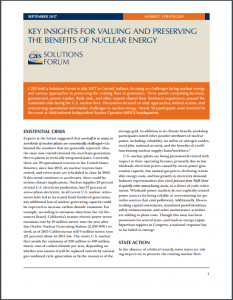Full Title: Key Insights For Valuing And Preserving The Benefits Of Nuclear Energy
Author(s):
Publisher(s): Center for Climate and Energy Solutions
Publication Date: October 1, 2017
Full Text: Download Resource
Description (excerpt):
Experts at the forum suggested that one-half to as many as two-thirds of nuclear plants are economically challenged – far beyond the numbers that are generally reported. Also, the issue now extends beyond the merchant generation fleet to plants in vertically integrated states. Currently, there are 99 operational reactors in the United States. However, since late 2012, six nuclear reactors have retired, and seven more are scheduled to close by 2025. If this trend continues or accelerates, there could be serious climate implications. Nuclear supplies 20 percent of total U.S. electricity production, but 57 percent of zero-carbon electricity. As all recent U.S. nuclear retirements have led to increased fossil fuel-fired generation, any additional loss of nuclear generating capacity could be expected to increase carbon dioxide emissions. For example, according to emissions data from the Air Resources Board, California’s in-state electric power sector emissions rose by 10 million metric tons the year after San Onofre Nuclear Generating Station (2,250 MW) retired; as of 2015 California was still 9 million metric tons (21 percent) above its 2011 low. The entire U.S. nuclear fleet avoids the emissions of 290 million to 408 million metric tons of carbon dioxide per year, depending on whether you assume it will be replaced entirely by natural gas combined cycle generation or by the resources of the average grid. In addition to its climate benefit, workshop participants noted other positive attributes of nuclear power, including: reliability, no sulfur or nitrogen oxides, rural jobs, national security, and the benefits of a wellfunctioning nuclear supply chain/workforce.
U.S. nuclear plants are being prematurely retired with respect to their operating licenses, primarily due to low wholesale electricity prices caused by excess power generation capacity, low natural gas prices, declining renewable energy costs, and low growth in electricity demand. Industry representatives also cited pressure from Wall Street to quickly retire money-losing assets, as a driver of early retirements. Wholesale power markets do not explicitly reward power sources for being reliable or zero-emitting (or penalize sources that emit pollution). Additionally, life-extending capital investments, mandated post-Fukushima safety enhancements, and other maintenance activities are adding to plant costs. Though this issue has been prominent for several years, and nuclear energy enjoys bipartisan support in Congress, a national response has so far failed to emerge.
